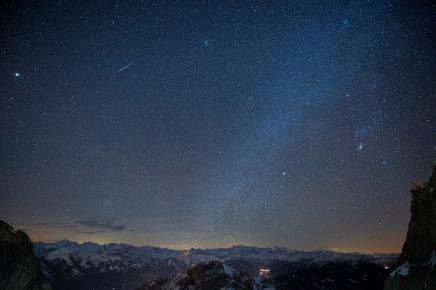(sda) More precisely: the night of December 13 to 14. The maximum number of falling stars this year coincides with the waxing moon, which does not set until well after midnight and before that lights up the sky. Therefore, especially in the morning hours are ideal for observation.
Fortunately, experience has shown that the swarm, named after the constellation Gemini – Gemini in Latin – produces many bright falling stars. To see the pre-Christmas sky, dark places far from light-flooded cities are best, but the brightest Gemini can also be seen in the sky of a big city. If you want to photograph the meteor shower, you should mount a wide-angle lens camera on a tripod and choose a long exposure.
Although they are among the largest swarms of falling stars of the year, Geminids are mostly in the shadow of the more famous Perseids, which light up each year in the August sky. The fact that Geminids are less popular is primarily due to the season of their appearance: the cool and often cloudy December weather in December provides shooting star hunters more uncomfortable viewing conditions than the mild Persian nights in summer.
When naming the Geminid Swarm, the constellation Gemini with its bright main stars Castor and Pollux was the godfather, because shooting stars seem to fall from exactly that direction. Astronomers refer to the seemingly common starting point of meteor orbits as radians – so the Geminids’ radiation is in twins.
In fact, the smell comes from a cloud of dust that crosses our Earth in its orbit around the Sun at the same time each year. Dust particles enter Earth’s atmosphere, where they then create a glowing phenomenon known as falling stars.
However, the origin of this dust cloud is unusual in Gemini. As a rule, meteor streams are the result of small remnants of comets – tail stars that release dust as they approach the scorching sun, which then spreads over the comet’s orbit.
For example, the origin of the Perseids lies in the cosmic dust path of comet “Swift-Tuttle”, which visits the sun approximately every 130 years. The Gemini dust cloud is different: it does not come from a comet, but rather from a small asteroid – a small, rather solid object in our solar system.
The asteroid of Gemini is called Phaeton. It was only discovered in 1983 and orbited the Sun in less than a year and a half. Research has shown that the trace of Phaeton dust, which is unusual for asteroids, can be explained by the ice beneath its surface.
Geminids also have other special features. Stream meteors move relatively slowly across the sky. The reason for this is the low speed with which the particles of Gemini sink into the atmosphere: it is “only” 122,000 kilometers per hour – and for Perseids it is an impressive 212,000 kilometers per hour.
Another peculiarity of Geminids is that in the hours of the most falling stars, the fainter meteors light up first and only then the brightest ones. Those who believe in making a wish at the sight of a falling star should look forward to these shining Geminis—especially in the run-up to Christmas.

“Prone to fits of apathy. Zombie ninja. Entrepreneur. Organizer. Evil travel aficionado. Coffee practitioner. Beer lover.”





More Stories
Windows 11: Update brings ads in start menu
Voyager 1 is once again sending data from deep space
Use two Bluetooth headphones at the same time